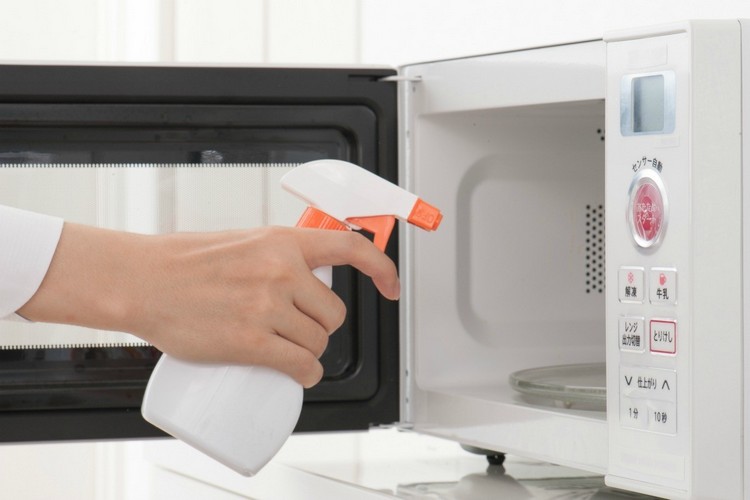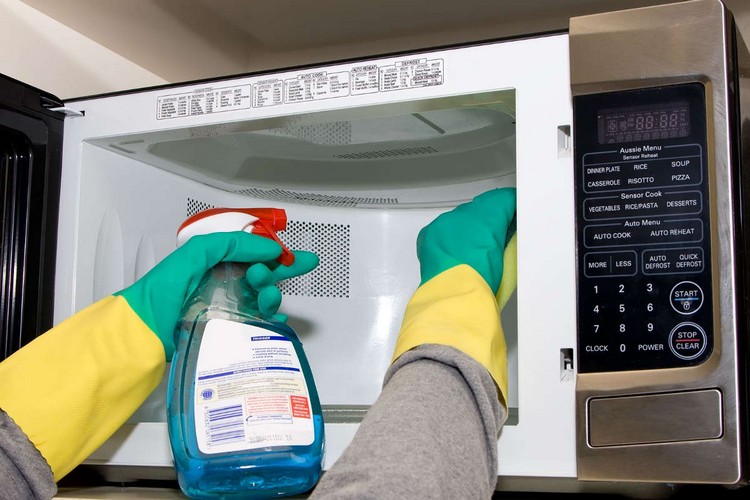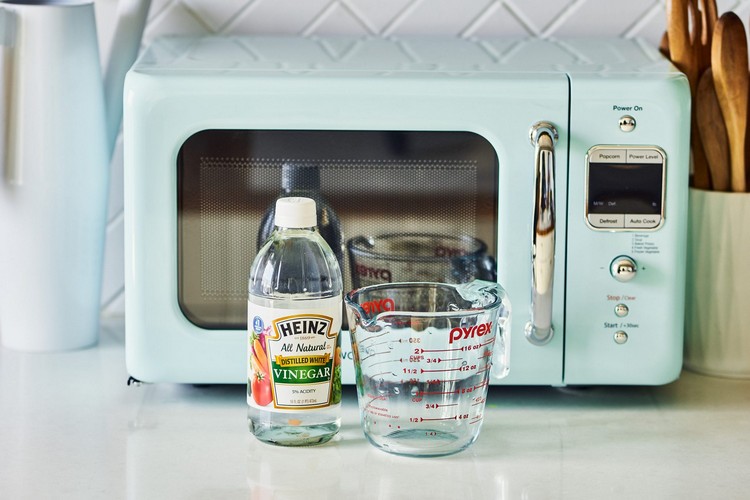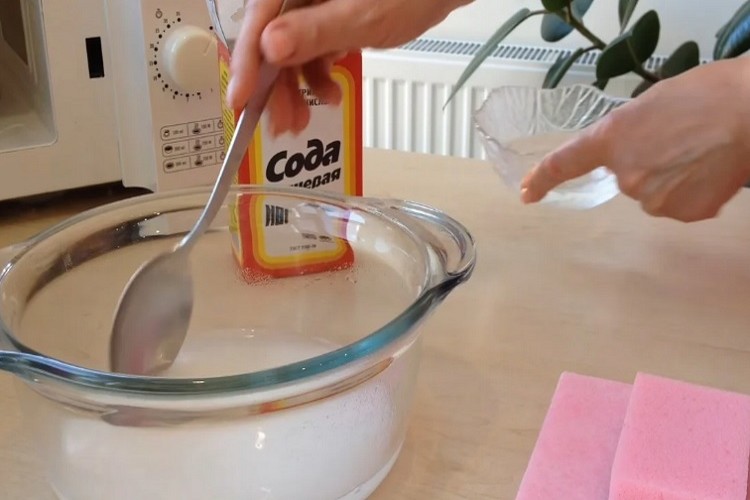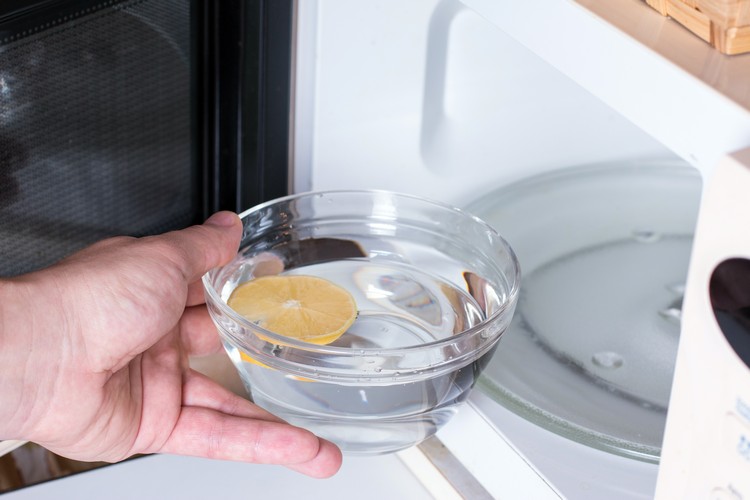Advice on how to clean microwave oven grease inside and outside: a review of products and cleaning methods
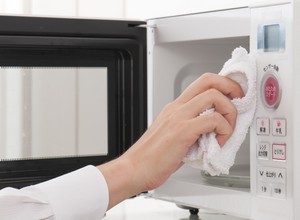 The microwave oven is a really convenient appliance in the kitchen.
The microwave oven is a really convenient appliance in the kitchen.
But it has one significant drawback: over time, stains are bound to form on the walls of the inner chamber.
This happens even if the microwave is used exclusively for heating food or defrosting semi-finished products.
And cleaning it, especially if the chamber is made of stainless steel without any coating, can be extremely difficult.
But in practice, there are several recommendations that will allow you to cope with even the most stubborn stains in just 10 - 15 minutes.
Table of Contents
How to prepare your microwave oven for cleaning
Immediately before cleaning the interior chamber it is necessary:
- Disconnect the appliance from the power supply.
- Remove the tray plate in the microwave.
You should also clarify whether the microwave oven supports the self-cleaning function. This information is necessarily specified in the technical manual.
How to remove grease
The most "difficult" stains are from stale grease stuck to the walls.
You can get rid of them with the help of:
- special detergents directly for microwave ovens;
- stove and pan cleaners;
- products to remove grease stains ("anti grease");
- window cleaners.
Microwave oven cleaners
In stores you can find on sale a detergent specifically for microwave ovens. For example, these are produced by Green and Clean, Sano and many others.
Their key difference: they also remove unpleasant odors, but do not damage the surface of the inner chamber (even if it is bioceramic or acrylic).
Cleaners for cooking stoves and pans
It should be noted right away that they come in two types:
- With abrasive components. Most of them are powders for cooking stoves. It is not recommended to use them to clean microwave ovens, because you can scratch the coating of the inner chamber of the microwave. This will definitely lead to the formation of corrosion, and it will be difficult to remove the rust and repair the surface.
- Without abrasive components. As a rule, these are gels that must be sprayed beforehand or applied with a dry sponge. Really allow you to get rid of even the most stubborn greasy stains, but do not always help remove the unpleasant smell.
Grease removers
Predominantly used for the "restoration" of old pans.
Excellent against grease, but before using it, it is recommended to test: apply a small amount of detergent to an inconspicuous area of the microwave (near the back or bottom). This is necessary to make sure that the gel will not harm the enamel, that is, the composition does not contain "aggressive" components.
Window Cleaner
Is an alternative to specialized means for cleaning microwave ovens.
In the composition of such liquids there are no abrasive components, so it is almost impossible to damage the coating of the inner chamber. At the same time in the composition is alcohol (ethanol) - it perfectly removes unpleasant odors.
It is enough to spray it on the inner chamber, hold it for 5 - 10 minutes, and then - wipe with a dry rag (even better - microfiber). But this option will not help to cope with stubborn stains.
Handy tools for cleaning microwave ovens
In any kitchen, there are plenty of tools you can use to clean even the dirtiest microwave. It is not necessary to use special cleaning gels and solutions.
Experienced housewives recommend removing grease stains and unpleasant odor with the help of:
- vinegar;
- hydrogen peroxide;
- Citric acid solution;
- orange or lemon peel;
- baking soda.
Vinegar
The main advantage of vinegar: it helps to get rid not only of stubborn grease stains, but also of oxide plaque on the inner walls of the microwave oven.
Use as follows:
- mix in a separate bowl 3 tablespoons of vinegar and 0.5 cup of water;
- Put the bowl in the microwave oven;
- Turn the microwave on to maximum heat for 5 to 10 minutes.
After 5 - 10 minutes the microwave should be turned off, unplugged, remove the dishes from it and wipe the walls of the inner chamber with a sponge and dishwashing liquid. Vinegar is not only excellent at removing grease stains, but also easily removes unpleasant and pungent odors (for example, after cooking meat dishes with a lot of spices).
Hydrogen peroxide
Hydrogen peroxide is a very good grease breaker.
You can use it to clean your microwave oven as follows:
- add 1 teaspoon of dish detergent and 1 tablespoon of hydrogen peroxide to 0.5 cups of water;
- Stir the mixture thoroughly until it forms a foam;
- Apply with a sponge to the inside walls of the microwave, leave for 2 to 3 minutes;
- moisten a cloth or sponge in hydrogen peroxide - wipe off the remains of the solution.
If necessary, repeat the procedure. The door of the microwave oven can be cleaned in the same way, as well as to remove traces of yellowing on the body itself.
Citric acid solution
It is good for removing grease, unpleasant odor.
To prepare the solution, you need to mix 0.5 cup of warm water and 2 - 3 teaspoons of citric acid. Stir thoroughly until all the crystals are completely dissolved (otherwise they will work as an abrasive component, that is, you can scratch the coating). Using a sponge, apply to the surface of the inner chamber of the microwave, and after 2 minutes - remove with a damp cloth.
Cleaning with citric acid solution should not be done if the inner chamber material is stainless steel (and "heat resistant" too, it is the same material) or acrylic.
Orange or lemon peels.
Cleans exactly the same way as a solution of citric acid (the cleaning component they have the same). But if you believe the reviews, with "old" grease stains, this method will not fix. But you can use it as an alternative for regular microwave cleaning. Orange peels are also good and quick at removing the smell from spices.
If the microwave is not planned to be used for a long time, you can also treat the walls of the inner chamber with lemon peels for storage. This will prevent the formation of mold, fungus.
Soda
Baking soda is effective against greasy stains, but you need to use it carefully. It is not necessary to prepare "mush" and rub it on the walls of the inner chamber - micro-scratches will definitely form. It is much more effective to prepare an aqueous solution and "steam" with its help the microwave.
Step by step, it looks like this:
- To 0.5 cup of water, add 1 - 2 drops of dishwashing detergent. More - no need, as there will be too much foam.
- Add 2 teaspoons of baking soda, mix the solution thoroughly.
- Place the solution in the microwave, also put a wooden spoon or spatula in the dish (will prevent overheating of the dish).
- Turn on the microwave at maximum power for 5 minutes.
- Afterwards, wipe the walls with a soft, damp sponge. After removing the plaque formed is enough to wash the microwave with a dishwashing detergent. This tip is especially useful when "fighting" with burnt food.
Cleaning with steam
This is the most "environmentally friendly" and safe option. It is also recommended for those who are allergic to many cleaning agents.
Cleaning is done as follows:
- Pour about 150 milliliters of water into a glass bowl and place a wooden spoon or spatula;
- put the bowl in the microwave, turn on the heat at maximum power;
- After 5 minutes - turn off, unplug from the mains;
- Carefully remove the bowl and the tray, wipe the walls with a dry cloth.
To get rid of particularly stubborn stains the procedure can be repeated 2 - 3 times. The only disadvantage of this method is that it does not allow to remove the unpleasant smell.
It should also be noted that some microwave ovens even have a special mode "Auto Clean". It works on the same principle, but in addition, convection can be activated (with the help of a fan, the steam is blown harder along the inner chamber).
How to get rid of unpleasant odor in the microwave
Unpleasant smell is bound to occur with regular use of the microwave oven.
More often than not, it is caused by:
- Cooking meat dishes with large quantities of spices.
- Combustion of food (when it gets on the inner walls or under the turntable plate).
- Creation of grease stains.
- Unsustainable use of the microwave.
The easiest way to remove the unpleasant smell is to use natural coffee. It is enough to boil it (1 teaspoon per 1 cup of water), let it cool, and then - rub it on the inside walls. After 5 minutes - rinse with dishwashing detergent and water.
No less effective is a solution with the addition of activated charcoal. For 50 milliliters of water you need to add about 4 - 5 tablets, mix everything thoroughly. Apply for 10 minutes, after - remove with a damp cloth or sponge.
Some microwaves have a standard function to remove unpleasant odor. Performed by a powerful blowing by a built-in fan (with the door open). But in practice - it does not always help.
Another way to get rid of outside odors is to use:
- orange peels;
- Vinegar (steam cooking).
Contamination prevention
Although cleaning the microwave oven at home is not time-consuming, preventing the formation of stains is quite possible.
The following tips are recommended:
- When heating food, defrosting or cooking, cover the plate with a special dome lid. Sold in cookware stores. They are made of a special heat-resistant food plastic. But this option is not suitable, for example, when using the grill.
- After each use, wipe the walls of the inner chamber of the microwave with a dampened cloth, without using detergents. Any grease that has been heated up should be removed immediately.
- If the oven is rarely used, wipe the inside with orange peels at least once a week. They prevent mold from forming, prevent corrosion, and also remove unpleasant odor.
By the way, manufacturers in the instructions that come with microwave ovens recommend cleaning after every time you cook or reheat your food. Even if you just decide to peel the tomatoes! But it's unlikely that anyone would take that much care with a kitchen appliance.
Precautions When Cleaning a Microwave
When cleaning the microwave, it is imperative that you follow the following rules:
- Do not use metal tools for cleaning. This should also include "scrubbers". This will definitely lead to the formation of micro-scratches, in places which will begin to show corrosion. And bioceramics from such "care" simply cracks.
- Do not use detergents that contain chlorine and its derivatives. Make sure you study the composition beforehand!
- There are places for cleaning, for which you have to partially disassemble the microwave. Doing it yourself is categorically dangerous. There are powerful capacitors inside the microwave oven. So even if the technique is unplugged, it does not mean that it will not be able to "electrocute".
- To remove crumbs from hard-to-reach places, you can use the most common or a car vacuum cleaner.
Bottom line, there are a ton of ways to clean a microwave. The best option is to use specialized products for microwave ovens. They do not contain chlorine, abrasive components, they do not corrode enamel, do not damage ceramics or acrylic. And they are not more expensive than dishwashing detergents. The cleaning itself is recommended at least once every two weeks, and after cooking meat dishes.
Useful video
How to clean the microwave with citric acid will tell in the video:



